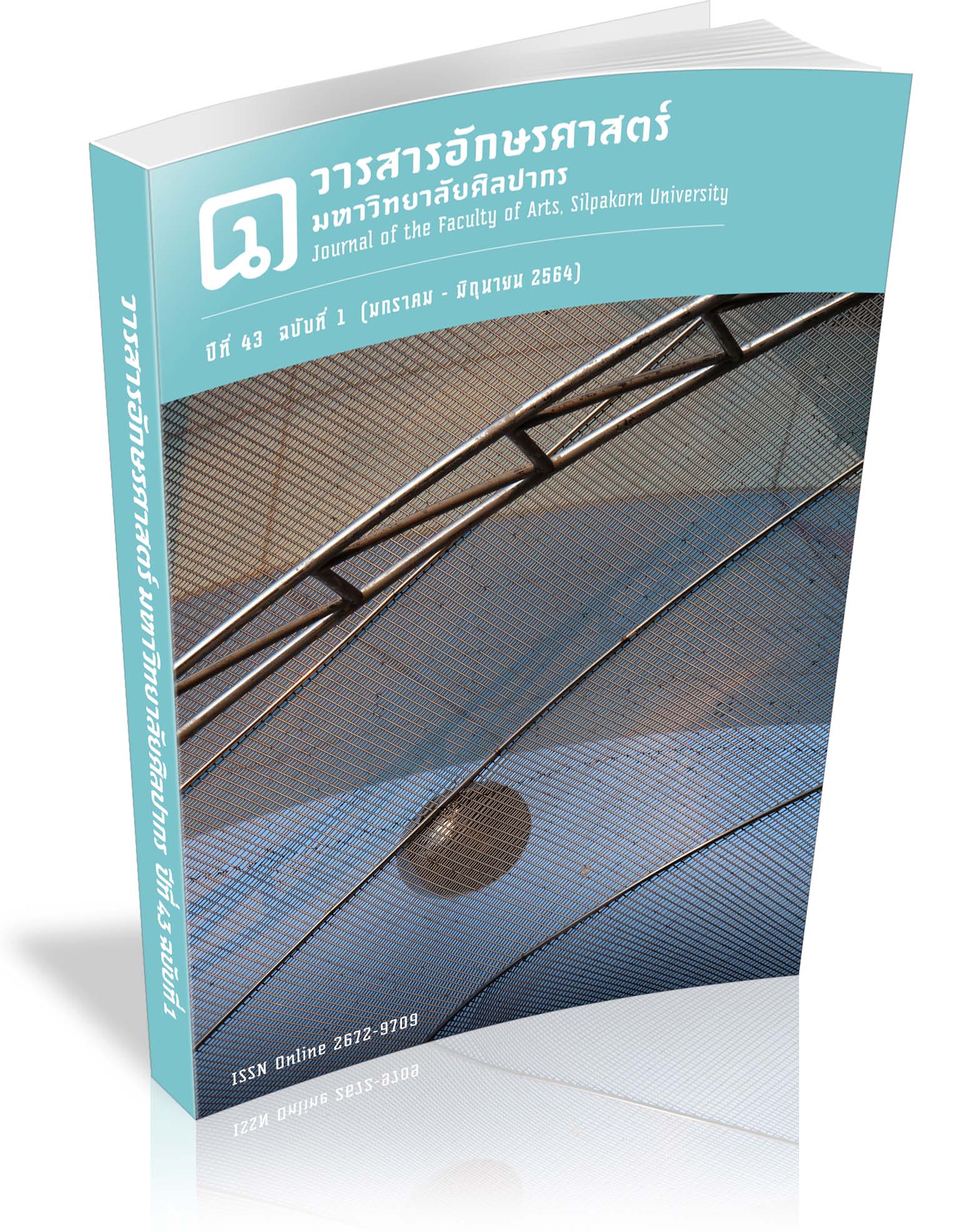The Relationship between Toponym and Geographical Characteristics for Places through Isan Folk Songs
Keywords:
Isan Folk, Sense of Place, Toponym, Jintara Poonlarp, Spatial DistributionAbstract
Isan folk songs are literary works which record situations reflecting the living conditions and lifestyles of Isan people. This study aims at classifying toponym types and identifying the spatial distribution of the relationship between toponym and geographical characteristics of songs by Jintara Poonlarp in the forms of albums and singles produced between 1987 and 2019. This study employs a semantic grouping theory and differentiation theory to investigate the toponym of 45 songs. In addition, this study uses Average Nearest Neighbor function with Geographic Information System and geographical concepts to identify the spatial distribution of 32 songs. The findings suggest that the classification of toponym types includes physical characteristics (73.33%), cultural characteristics (8.89%), a combination of physical and social characteristics (6.67%), and a combination of physical and cultural characteristics (4.44%). Patterns of distribution were random, but a cluster pattern was found in the middle of the Korat basin. The Isan folk songs reveal the relationship between physical, social and cultural characteristics. This study reflects songs and feeling about places, spatial views, lifestyles and the promotion of culture and development of tourist routes following Isan folk songs.
Downloads
References
Carney, G. (1998). Music geography. Journal of Cultural Geography, 18(1), 1-10.
Chaikee, P., & Kaeowichian, C. (2018). Analysis of the concepts and the arts of language usage in Thai folk songs composed by Sala Khunnawudh. Phetchabun Rajabhat Journal 20(1), 87-96. (In Thai)
Chuthap, W. (2018). Development of Thai society through Thai folk songs. Rusmilae Journal, 39(1), 33-60. (In Thai)
Coburn, C. A., & Smith, A. W. (2005). Musical landscapes using satellite data. Paper presented at the SPARK Festival of Electronic Music and Art. 3rd Annual Conference. University of Minnesota, Minneapolis, MN.
Congreat, S. (2017). The techniques of language used in country songs to communicate the identity and politics of the Isan diaspora. Veridian E-Journal, Silpakorn University (Humanities, Social Sciences and arts), 10(2), 1577-1594. (In Thai)
Connell, J., & Gibson, C. (2004). World music: deterritorializing place and identity. Progress in Human Geography, 28(3), 342-361.
Detchatree, N., Sanpot, K., Auesriwong, A., & Turistut, T. (2017). The management strategy for tourist attractions at the sacred site of Khamchanod, Bandung district, Udonthani Province. Humanities and Social Sciences, 34(3), 224-246. (In Thai)
Fouberg, E. H., & Murphy, A. B. (2020). Human geography: people, place, and culture: John Wiley & Sons.
Hu, L., Sun, A., & Liu, Y. (2014). Your neighbors affect your ratings: on geographical neighborhood influence to rating prediction. Paper presented at the Proceedings of the 37th international ACM SIGIR conference on Research & development in information retrieval. Queensland, Australia
Kaewphat, S. (2003). Naming of Thai country songs during, 1997-2002. Master of Arts, Department of Thai. Chulalongkorn University, Thailand. (In Thai)
Krims, A. (2007). Music and urban geography: Taylor & Francis.
Lakul, A. (2018). A study of identity of Northern and Northeastern regions through song literature. Wiwitwannasan, 2(2), 63-80. (In Thai)
Leidner, J. L. (2008). Toponym resolution in text: Annotation, evaluation and applications of spatial grounding of place names: Universal-Publishers.
Lekun, W., & Chanthao, R. (2017). Language using in districts naming of Northeastern Thailand. Humanities and Social Sciences, 34(3), 100-117. (In Thai)
Miller, H. J. (2004). Tobler's first law and spatial analysis. Annals of the Association of American Geographers, 94(2), 284-289.
Mitchell, A., & Minami, M. (1999). The ESRI guide to GIS analysis: geographic patterns & relationships (Vol. 1): ESRI, Inc.
Moralai, S. (2014). Draw territory Isan. Walailak Abode of Culture Journal, 14(1), 65-76. (In Thai)
Nash, P. H., & Carney, G. O. (1996). The seven themes of music geography. Canadian Geographer/Le Géographe canadien, 40(1), 69-74.
Phuangsuwan, P., Thanapotivirat, P., Chairatana, P., & Chairatana, K. (2020). Northeastern culture and return of Thai country music. Journal of Legal Entity Management and Local Innovation, 6(3), 139-157. (In Thai)
Prueksa, R. & Sungkaman, U. (2018). A study of naming in Thai classical songs. Vacana, 2(2), 1-23. (In Thai)
Saiheng, P. (2019). Isan power of social media. Rusamilae Journal, 40(2), 7-14. (In Thai)
Qian, S., Kang, M., & Weng, M. (2016). Toponym mapping: a case for distribution of ethnic groups and landscape features in Guangdong, China. Journal of Maps, 12(1), 546-550.
Rattanapakdee, O. (2016). The geographical nature, local history and socio-cultural aspects: reflection from toponyms of village names in Lampang province. Manutsat Parita. Journal of Humanities and Social Sciences Review, 1(1). (In Thai)
Shobe, H., & Banis, D. (2010). Music regions and mental maps: Teaching cultural geography. Journal of Geography, 109(2), 87-96.
Sritalalai, A., & Thalang, C. N. (2020). The signficant level of marketing mix of tourist sites with faith Naga story in the northeast region (Udon Thani Province - Nong Khai Province - Bueng Kan Province - Nakhon Phanom Province) Thailand. Rajamangala University of Technology Tawan-ok Social Science Journal, 9(1), 143-157. (In Thai)
Thippana, S. (2018). Speech Acts Usage in Songs of Jintara Poonlab R-Siam. Humanities and Social Sciences Journal, Ubon Ratchathani Rajabhat University, 9(1), 61-72. (In Thai)
Thippana, S., Thipphana, R., & Sudarat, P. (2020). Poverty characterisics of Isan people in Thai country songs of Mike Piromporn. Humanities and Social Sciences Journal, Ubon Ratchathani University, 11(1), 1-24. (In Thai)
Tosranon, T., & Prachaknet, P. (2017). The development of Thai country song communication through the storytelling of Thai social values from the past to the present. Journal of communication and innovation NIDA, 4(2), 1-30. (In Thai)
Wongwattana, U. S. (2016). Nominal-class marking in Thai. Songklanakarin Journal of Social Sciences and Humanities, 22(2). (In Thai)
Zhou, F., Claire, Q., & King, R. D. (2014). Predicting the geographical origin of music. Paper presented at the 2014 IEEE International Conference on Data Mining, pp 1115-1120, December 14 - 17, 2014. Shenzhen, China.
Downloads
Published
How to Cite
Issue
Section
License
ผู้เขียนบทความต้องยินยอมในข้อกำหนดต่าง ๆ ของวารสารก่อนส่งบทความตีพิมพ์




